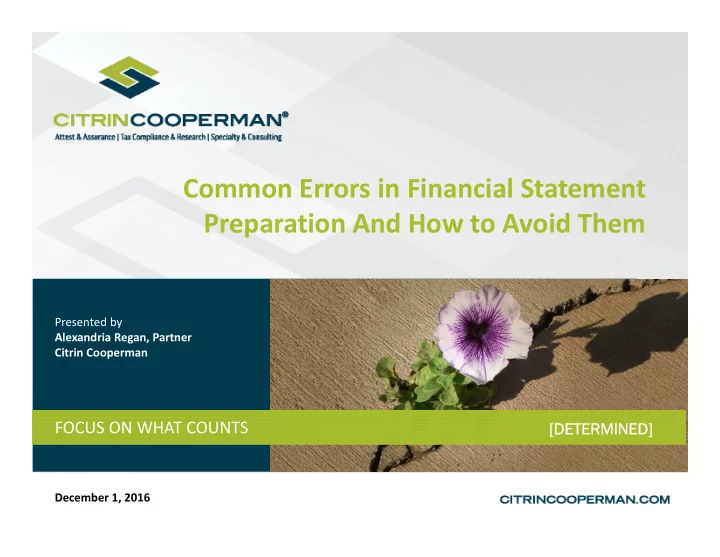

Common Errors in Financial Statement Preparation And How to Avoid Them Presented by Alexandria Regan, Partner Citrin Cooperman FOCUS ON WHAT COUNTS [DETERMINED] [DETERMINED] December 1, 2016
What do we want to achieve today? • Identify common errors found in not-for-profit financial statements • Understand the impact errors could have on financial reporting • Identify how to avoid these errors 2
Categories of Reporting & Disclosure Errors • Revenue Recognition • Net Asset Classification • Financial Statement Presentation • Disclosure Errors in the Notes to Financial Statements 3
Revenue Recognition • Contribution vs. exchange transaction Gray area - open to judgment 4
Revenue Recognition • Contribution vs. Exchange If $$$ is advanced, recognition is different: Contribution = net assets Exchange = deferred revenue until earned • Conditional vs. unconditional Recognize unconditional contributions Recognize conditional contributions when the conditions are substantially met • Promises to give vs. intentions Intentions to give are not recorded until contribution is received (inclusion in a will) Contributions receivable that are paid by donor-advised funds should not be recognized until the payment is received 5
Revenue Recognition • Discounting of multi-year contribution receivable Use a risk adjusted discount rate Rate determined at the date the promise to give is initially recognized – do not subsequently revise Amortize discount as a component of contribution revenue Remember – this is an estimate… • Grant accounting vs. GAAP • Restrictions Remember - only donors impose restrictions that create temporarily and permanently restricted net assets 6
Revenue Recognition • Contributed services GAAP recognition criteria Create or enhance nonfinancial assets Require specialized skills, are provided by those who possess those skills and would typically need to be purchased if not contributed (typically professionals and craftsmen) Whether or not the organization could afford the services at fair value is not a factor Improper recognition driven by: Matching requirement of a grant Desire of an organization to show “true” program costs Improper omission driven by: Inability of an organization to afford the services at fair value 7
Net Asset Classification • Debit balances in temporarily or permanently restricted net assets It is not possible to release funds greater than the net asset class balance (even if you anticipate future funds) • Board designated net assets recorded as temporarily or permanently restricted net assets Even if funds are designated/restricted for a purpose by the Board , they are still unrestricted for GAAP purposes • Contributions receivable due in future years recorded as unrestricted Multi-year pledges carry an implicit time restriction even if the gift is unrestricted for general operations 8
Net Asset Classification • Improperly presenting expenses as temporarily or permanently restricted net assets All expenses must be categorized as unrestricted Expenses that satisfy a donor restriction related to temporarily restricted net assets are unrestricted Recognize the satisfaction of donor-imposed restrictions on net assets through “net assets released from restriction” on the statement of activities • “Choosing” when to release temporarily restricted net assets in a period other than when event of release has occurred If expenses are incurred for which both restricted and unrestricted net assets are available, the organization is required to use the restricted net assets first 9
Financial Statement Presentation • Failure to account for an operating lease using straight- line (sofp & soa) • Improper capitalization and amortization of leasehold improvements (sofp & soa) Amortize over the shorter of: Useful life of the asset Lease term • Failure to report fundraising expenses (soa) If an organization receives contributions, it should have FR expense 10
Financial Statement Presentation • Failure to report gifts-in-kind (soa) Free use of program space is most commonly overlooked • Reporting activity “net” in the statement of cash flows Purchase and sales of investments Borrowings and repayments on long term debt Includes borrowings on LOC throughout the year, even if balance is $0 at year end • Failure to include a statement of functional expenses when required Currently all voluntary health and welfare organizations are required to have this 11
Disclosure Errors in Notes to Financial Statements Failure to disclose: • Adequate description of organization’s activities and programs • Tell your story! • Take credit for all the important work that you do and the amazing programs you operate! • Make sure all information is consistent. Remember – there is quite a bit of information available for public consumption… (Website, 990, UFR, etc.) • Information about contributed services Nature and extent of contributed services NFP’s are encouraged to report the fair value of contributed services NOT recognized in the notes 12
Disclosure Errors in Notes to Financial Statements Failure to disclose: • Policy on whether restricted contributions & investment income are treated as unrestricted if the restriction is met in the same year • Endowment disclosures Remember – this includes all funds “acting as endowment” which includes unrestricted board designated as well as temporarily and permanently restricted funds. Should not include permanently restricted net assets related to outstanding contributions receivable • Information about temporary restrictions Nature and amounts of restrictions 13
Contact Information Alexandria Regan, CPA Partner D: 781-817-1154 M: 978-340-1355 aregan@ citrincooperman.com Telephone: 781-356-2000 Braintree Office: 10 Forbes Road West, Braintree, MA 02184 Woburn Office: 444 Washington Street, Woburn, MA 01801 Fax: 781-356-5450 14
CONNECTICUT | MARYLAND | MASSACHUSETTS | NEW JERSEY | NEW YORK | PENNSYLVANIA | RHODE ISLAND
Recommend
More recommend